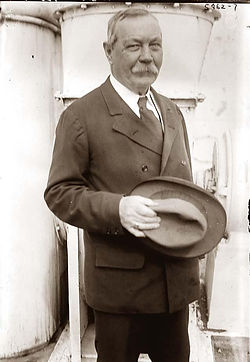Horoscopes
Birth Charts
Arthur Conan Doyle♊
Born on May 22, 1859 at 04:55 am in Edinburg, Scotland.
The Birth Chart
Ascendant: Gemini
Sun: Gemini/Taurus cusp in the Twelfth House
Moon: Aquarius in the Ninth House
Mercury: Taurus in the Twelfth House
Venus: Aries in the Twelfth House
Mars: Gemini in the Twelfth House
Jupiter: Gemini in the First House
Saturn: Leo in the Third/Fourth Houses
Uranus: Gemini in the Twelfth House
Neptune: Pisces in the Eleventh House
Pluto: Taurus in the Twelfth House
Vesta: Pisces in the Eleventh House
Chiron: Aquarius in the Tenth House
Eris: Pisces in the Eleventh House
North Node: Aquarius in the Tenth House
South Node: Leo in the Fourth House
Midheaven: Aquarius
Hygeia: Cancer in the Second House
Part of Fortune: Aquarius in the Tenth House




Biography
Scottish writer best known as creator of the modern detective story, and of the characters Sherlock Holmes and his colleague Dr. Watson. Studying at Edinburgh University, he received his medical degree in 1885 and practiced medicine until 1891, before devoting his time to his literary work. His first publication was in 1879 but he did not receive any recognition until "A Study in Scarlet" was released in 1887. Besides his great achievements in the history of detective fiction, he is also noted for historical romances. He was knighted in 1902.
The son of a civil servant who worked hard to support his brood of seven kids, Conan Doyle escaped the family domestic tension by reading for hours. He was a student at Stonyhurst Jesuit school, noted for its discipline, followed by a year of study in Austria. When he came home to enroll at Edinburgh
University's school of medicine, he was met by the sad spectacle of his dad, broken by depression, epilepsy and alcoholism. His dad was institutionalized for the rest of his life, causing great sorrow and hardship for the family.
Upon graduation, Conan Doyle served for a seven-month voyage as ship's doctor on an Arctic whaler. His income helped the family but it was almost more of an adventure than he could handle. He nearly died of typhoid fever, fought a ship's fire and had a close call in meeting a shark. Back on dry land, he resolved to stay there and opened a practice in Portsmouth, England. Conan Doyle was beginning the dark periods of depression, like his father, that plagued him the rest of his life.
As his practice built slowly, Conan Doyle filled his time with sports; cricket, rugby, golfing, boxing, billiards, as well as writing. His first short story was published in 1879 while he was still in school, but he primarily wrote as a diversion. Conan Doyle married his first wife, Louise Hawkins, in 1885 and their daughter Mary Louise was born two years later. His marriage stabilized him, and Doyle's stories began to markedly improve and gain great popularity. His medical practice began to fall by the wayside in his keeping up with the demand for Sherlock Holmes stories.
A son was born, Kingsley, and Conan Doyle was getting unheard-of prices for his stories, when his world crashed down; Louise was diagnosed with tuberculosis. Over the next few years, Conan Doyle developed insomnia, nightmares, depression and mood swings.
Some years before, on 3/15/1897, Conan Doyle had met 24-year-old Jean Leckie. Though they fell deeply in love, Doyle would not consider breaking up his marriage, and he and Jean had a platonic relationship over the next ten years. During that time, Conan Doyle volunteered to service in the Royal Army's medical corps during the Boer War in South Africa, was knighted by King Edward VII, and ran unsuccessfully for Parliament. He also traveled widely, lecturing in the United States, where he was wildly popular, and Europe.
After years of illness, Louise died on 7/04/1906. Conan Doyle and Jean were married on 9/18/1907. They had three kids in rapid succession, Denis, Adrian and Jean.
Since his days as a medical student, Conan Doyle had been interested in parapsychology and he had read and studied phenomena most of his life. After losing his eldest son, Kingsley, of pneumonia at the close of the great war, Conan Doyle became totally open about his belief in spiritualism, hoping to contact his boy. He also had specific ideas about the afterlife. In the last years of his life as his health slowly failed, he held nightly séances at home and underwrote the establishment of a psychic bookshop, library and museum. He spoke in Paris as acting president of the International Spiritualist Congress.
Conan Doyle died of heart and kidney failure 7/07/1930 in Crowborough. Many sincere attempts to contact him after his death met with failure.